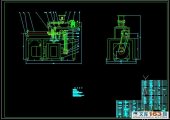高剪切式单螺杆挤压机设计(含任务书,开题报告,外文翻译,毕业论文说明书16000字,CAD图纸7张)
摘 要
目前膨化食品越来越受到人们的欢迎,而挤压技术在膨化食品中的应用也更加广泛。
在挤压机内的面团类食品中的水分由于处于压力之下成液态,然后从模板孔挤出时,过热的水分突然处于常压下,压力突然降低,水分蒸发成水蒸汽,产生伸张的和膨胀,这样使这种产品产生一种低密度轻质的状态。
挤压技术作为食品工业中一项非常重要的技术得到更大的发展,现代食品工业用的螺杆挤压机集混合、融合、蒸煮、改性反映、调质、组织化、成型、膨化等多种功能于一身,体现出有利于自动控制、便于灵活转产以及节能、节劳力、节省生产场地等优点。
单螺杆挤压机的结构简单、易于加工制造、成本低廉,广泛用于加工各种膨化小吃食品,本设计中设计一台单螺杆挤压机,其特点是高转速,高剪切率,外部无加热和冷却装置,而是利用其高剪切率产生的摩擦热来加热熔融原料使食品原料得到蒸煮熟化,从而生产出松脆可口的膨化谷物食品。设计将从挤压机的传动系统,挤压系统,喂料系统等进行完整的设计。
关键词:膨化食品;挤压技术;单螺杆挤压机
Abstract
At present puffs food more and more to receive people's welcome.
The extrusion technology in puffs in food the application to be also more widespread.In extruder pasta class food moisture content because is in under the pressure to become the liquid state,Then when squeezes out from the template hole, the superheat moisture content suddenly is in under the atmospheric pressure, the pressure reduces suddenly,The pressure reduces suddenly, the moisture evaporation steam, produces promotes and the inflation, like this causes this product to have one kind of low density light quality condition.
The extrusion technology took in the food industry an extremely important technology obtains a bigger development,Modern food industrial used screw rod extruder have the mix, the fusion, the steam boiling, the modification reflected, the quenching and tempering, the organization, the formation, puff and so on many kinds of functions,manifests is advantageous to the automatic control, is advantageous for produces a different product nimbly as well as the energy conservation, the festival labor force, saves produces merits and so on location.
The single screw extruder structure simple, easy to process the manufacture, the cost is inexpensive, widely uses in processing each kind to puff snack food,In the design designs a single screw rod extruder, its characteristic is the high speed, high cutting rate, the outside does not have the heating and the cooling system, but is uses the friction heat which its high cutting rate produces to heat up the fusing raw material enable food raw material to obtain the steam boiling curing, thus produces the pine crisply delicious to puff grain food.
The design from the extruder transmission system, the extrusion system, will feed the material system and so on to carry on the integrity the design.
Keyword: euffs food extrusion technology single screw extruder
研究内容
① 高剪切式单螺杆挤压机在食品工业中的应用及工作原理
② 高剪切式单螺杆挤压机的总体结构
③ 高剪切式单螺杆挤压机的主要参数计算
④ 高剪切式单螺杆挤压机的传动系统及挤压部件设计
拟采取的研究方法、技术路线、实验方案及可行性分析
(1)实验方案
掌握高剪切式单螺杆挤压机的工作原理,通过对其结构及特点的研究了解挤压机的结构,从而进行对挤压部件的研究和设计。
(2)研究方法
通过学习了解挤压机的结构参数,对挤压部件的参数进行计算及确定,按照挤压机的结构进行装配图及挤压部件零件图的绘制。
目 录
摘 要 III
Abstract IV
目 录 V
1 绪论 1
1.1 挤压技术介绍 1
1.1.1 挤压技术在食品生产中的应用 1
1.1.2 挤压技术在食品生产中的发展状况 1
1.1.3 挤压机生产膨化食品 1
1.1.4 挤压膨化原理 2
1.2 意义、目的、研究范围 2
1.3 本课题在国内外的发展概况及存在的问题 2
1.4 本课题研究内容 5
2 单螺杆挤压机整体设计方案 6
2.1挤压机的主要部件 6
2.1.1挤压机的供料部件 6
2.1.2螺杆 6
2.1.3机筒 6
2.1.4模头及模板 6
2.1.5其他 7
2.2挤压机的驱动装置 7
2.2.1 电动机的选用 7
2.2.2 传动比分配 8
3 挤压机零部件设计与计算 9
3.1 螺杆的设计 9
3.1.1 螺杆的结构 9
3.1.2 螺杆各部分参数 9
3.2 机筒结构设计 12
3.3 带轮结构设计与计算 12
4 螺杆和机筒强度计算及配合要求 16
4.1 螺杆强度计算 16
4.1.1 螺杆材料选取 16
4.1.2 螺杆校核计算 16
4.2 机筒强度校核 18
5 轴承布置与校核计算 20
5.1 径向轴承 20
5.2 推力轴承 21
5.3 键的强度校核 21
5.4 螺杆的生产能力计算 22
6 加料系统设计 23
6.1 螺旋直径和转速的确定 23
6.2 螺旋主要结构参数确定 23
6.3 电机选用 24
6.4 润滑油的选用 24
6.4.1 齿轮传动的润滑 24
6.4.2 滚动轴承的润滑 25
7 挤压机操作系统 24
7.1 安装 24
7.1.1 挤压机的安装基础 24
7.1.2 调整挤压机水平 24
7.1.3 机筒的安装 24
7.1.4 螺杆的装拆 24
7.1.5 模头的安装 24
7.2 挤压加工系统的操作与维护 26
7.2.1 开车前的准备工作 26
7.2.2 开车操作 26
7.2.3 运转中的检查 27
7.2.4 停机 27
7.2.5 维护保养 27
8 总结与展望 29
8.1 总结 29
8.2 展望 29
致谢 30
参考文献 31
|







